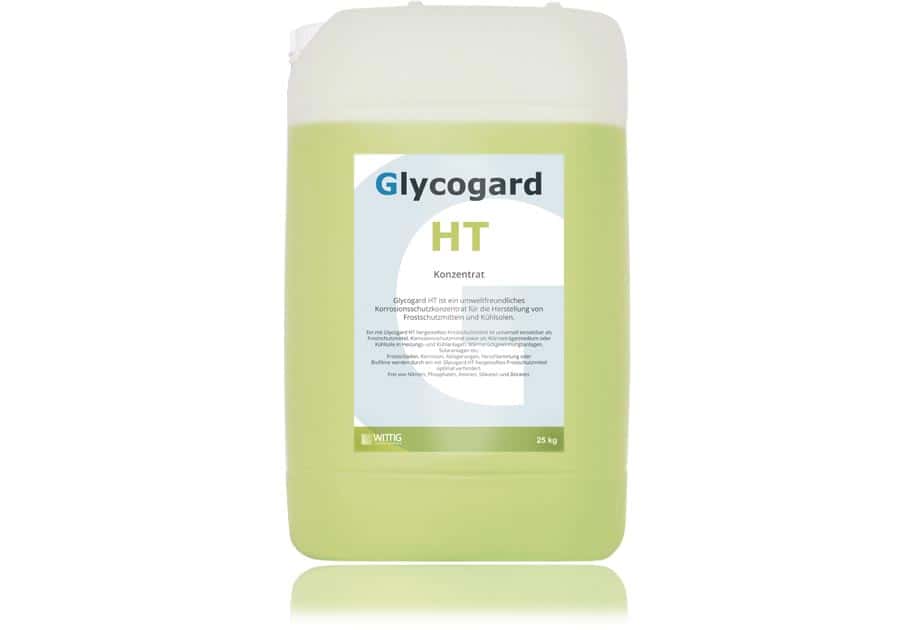Description
Glycogard HT is an environmentally friendly anticorrosive concentrate for the production of frost protection agents and cooling brines.
A frost protection agent produced with Glycogard HT can be universally used as frost protection agent, anticorrosive agent and as a heat carrier medium or cooling brine in heating or cooling systems. A frost protection agent produced with Glycogard HT optimally prevents frost damage, corrosion, debris, accumulation of mud or biofilms.
Glycogard HT is free of nitrites, phosphates, amines, silicates and borates. It is biodegradable and environmentally friendly. Glycogard HT is classified in the lowest water pollution class (1).
A frost protection agent produced with Glycogard HT is resistant in the long-term against putrescence and microbiological degradation and therefore precipitations and the accumulation of mud are prevented.

Typical areas of application
Additive for the production of frost protection agents and cooling brines.
Packaging sizes
- 25 kg / 30 kg PE canister
- 220 kg Barrel
- 1.000 kg IBC
- 24.000 kg Tank vehicle
The thermodynamic properties and other specific product features available to download in PDF format.
Application
Glycogard HT is delivered in liquid form and can therefore be very easily diluted in monoethylene glycol, propylene glycol and other glycols.
Glycogard HT wird wie folgt konzentriert:Glycogard HT is concentrated as follows:
Alternatively, a colourant can be added.
A product according to the above-mentioned formulation is used in the end application in diluted form (between 33 and 60% in water).
The product can be universally used as a frost protection agent, anticorrosive agent, heat carrier medium, cooling brine etc.
Further information
Corrosion protection
Glycogard HT contains a complex combination of corrosion inhibitors which optimally protect metals from corrosion. This corrosion protection can be used for all important metals which are generally used for the construction of heating and cooling systems and industrial plants. Installations made of copper, brass, solder, grey iron, aluminium, steel and iron are optimally protected from corrosion even if they are used in multi-metal installations.
Other information
Pure water/glycol mixtures have very distinctive corrosive properties. Therefore never use pure water/glycol mixtures without inhibitor equipment. For applications in connection with food, refrigeration or heating of food and for pharmaceutical and cosmetic areas of application we recommend formulating a product on the basis of propylene glycol (MPG).
Application guidelines
for MEG and MPG based products
Galvanised components are to be avoided, as zinc is generally volatile with glycol and products which contain glycol. The water which is used for the production of the solution should have a maximum hardness of 25 °dH and a chloride content of 100 mg/l maximum. Generally, tap water fulfils these requirements. Pipe connections are to be made of hard solder and chloride-containing flux materials are to be avoided or are to be removed completely by flushing after usage. Scalings on copper components, metal swarf and contaminations are to be removed completely before the plant is filled. The operated plant must not be in contact with any external electrical potential. When installing the plant, it is to be ensured that the future operation is not interrupted by circulatory disturbances caused by air cushions or debris. The plants that are operated with Glycogard HT are to be installed as closed systems and are to be filled completely and vented directly after the pressure test is carried out. Gas and air cushions are to be removed immediately. Breathers are to be applied in such a way that they constantly keep the system free from air and oxygen and no air can be sucked in in case of low pressure. If an existing plant is to be filled, the corrosion condition should be checked first. Before a system that is damaged by corrosion is filled, it is to be reconstructed completely.
| Chemical name | Combination of corrosion inhibitors, dissolved |
|---|---|
| Appearance | yellowish liquid |
| Packaging | Canisters / barrels / IBCs / tank vehicles |
| ADR | KI 0 Ziff |
| WHC | 1 |
| Labelling | omitted |
| Applied concentration | 10% in MEG or MPG |
| Operating temperature range | -40 to +150 °C |
| Application areas | Heating systems, cooling and refrigeration systems, air conditioners, biogas plants, solar plants, block heating stations, heat recovery plants, heat carrier media in industrial and production plants, frost protection agents and anticorrosive agents in water and heating circuits, heat carrier media in the area of geothermal energy etc. |
| Density (20 °C) | 1,110 – 1,155 g/cm³ |
| pH-value | 7,0 – 8,5 |
| Boiling point (1013 mbar) | from 100 °C |
Frost protection values of a MEG-based product
| Active content (volume) | Frost protection in °C |
|---|---|
| 30 % | -16 |
| 40 % | -25 |
| 50 % | -38 |
Frost protection values of a MPG-based product
| Active content (volume) | Frost protection in °C |
|---|---|
| 30 % | -14 |
| 40 % | -22 |
| 50 % | -32 |